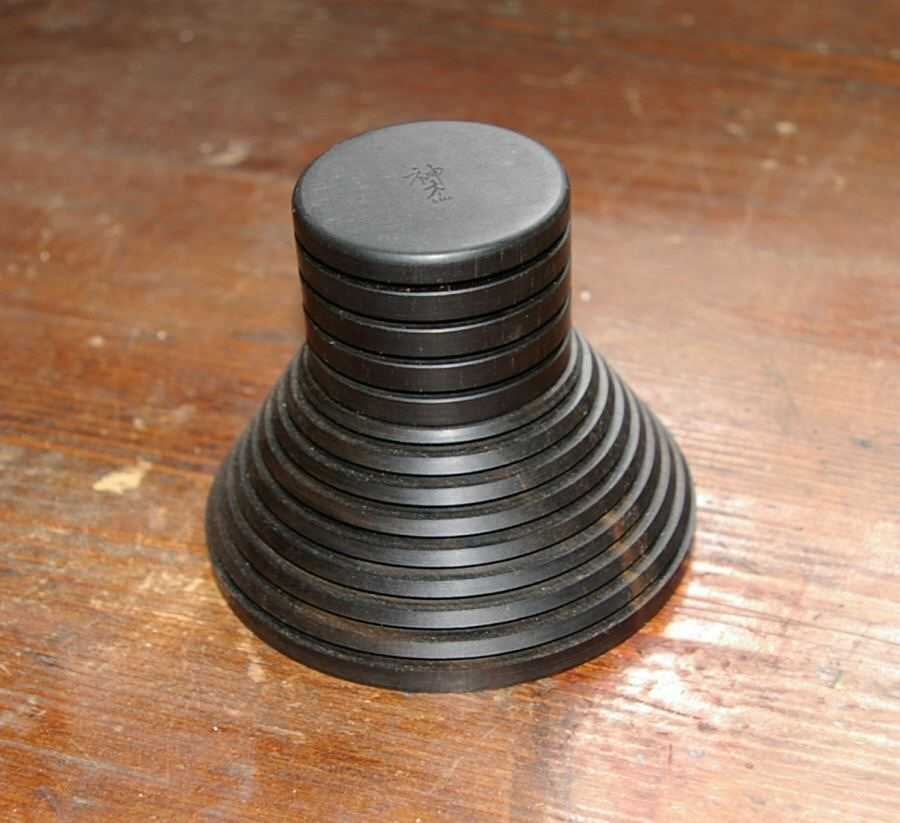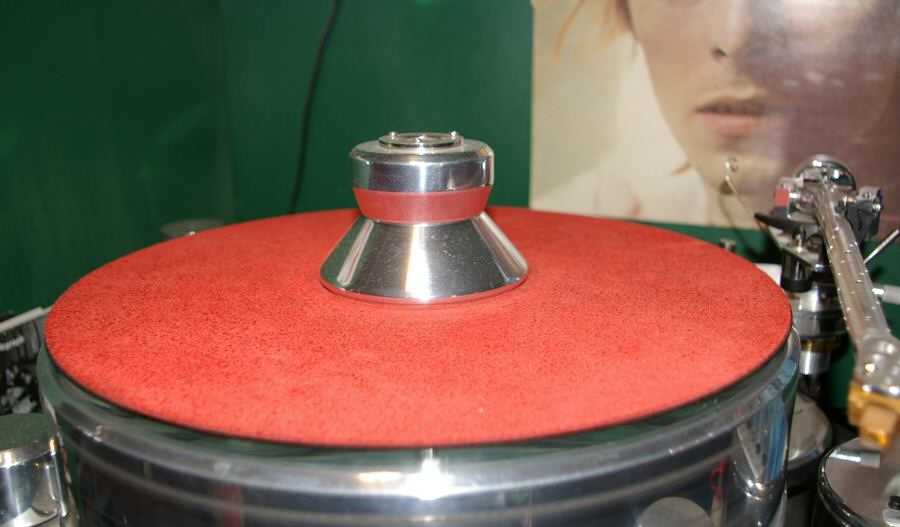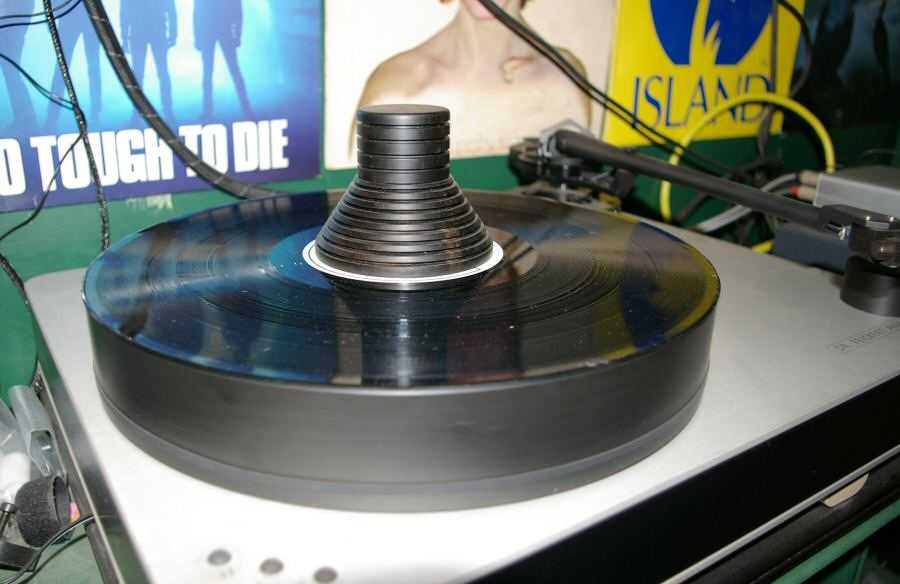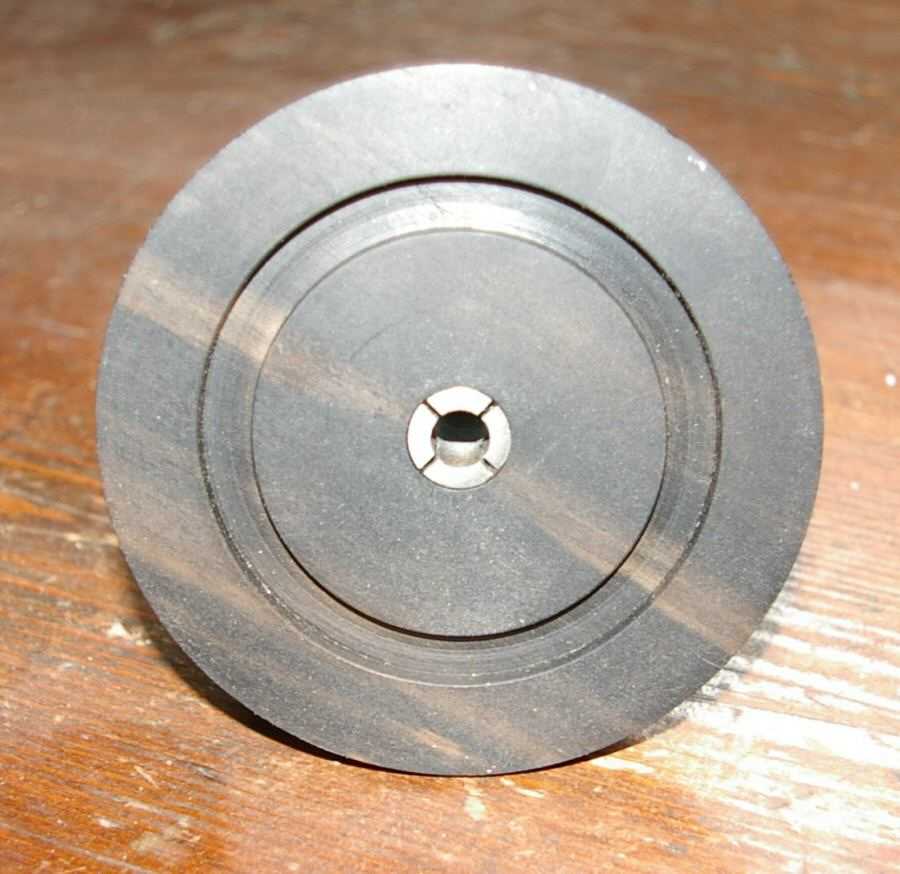
Product: Shun Mook Record Clamp
Manufacturer: Shun Mook - USA
Cost, approx: lots... (YMMV)
Reviewer: Geoff Husband - TNT France
Reviewed: July 2011

Nothing intrigues me more in hi-fi than very highly thought-of engineers offering utterly different solutions (and opinions) on how to get the best from a vinyl disc. The reason is that it gets me thinking. If guru 'A' is telling me one thing and making it all sound so convincing, and guru 'B' is saying the complete opposite then I just have to try and figure out what is going on.
There are lots of such topics, AC or DC motors, metal or plastic platters, inverted or conventional bearings, suspended and solid plinth, high mass or low mass, damped or undamped bearings – the list is endless and in most cases there is no middle ground... There are people who will go to the barricades over one position or another and have utterly convincing and logical arguments for each. The result is that though a little confused I've come to believe the old adage 'there's more than one way to skin a cat' is the best I can come up with.
Which brings us to the current subject – the record/platter interface with particular reference to the use of pucks and clamps, and specifially the effect of the Shun Mook record clamp.
What you'll get in most publications is a review of the effects of such a clamp – what I hope to do here is to show how that is hopelessly misleading.
Let us consider to begin with two very highly thought of turntables from engineering companies with a long tradition of innovation and excellence, and which I consider of very similar quality (though quite distinctive). The Michel Orbe and the Roksan Xerxes...
These two turntables take polar opposite positions when it comes to the record/platter interface. Let's look at what the Orbe and Roksan are up against.
When a record is played on a turntable vibrations will be pumped into the record itself and these vibrations will inevitably be picked up by the stylus and in turn be amplified and added to the music. This is bad. The source of these vibrations are many and varied. The single biggest source (in any quality table) is the stylus itself as it tracks the record. Play a record with the amp off and you'll be able to hear the music quite easily – quiet and 'tinny' but there. That vibration of the stylus in groove gets to your ear via the air, but more of it will enter the disc itself and cause it too to vibrate. Inevitably these vibrations will reflect back to the stylus where they are picked up and amplified to become part fo the music signal. This is very bad noise because it it music dependent and delayed (like a quiet echo) – the ear is more sensitive to this than random noise (like surface noise) and it has the effect of reducing dynamics and blurring detail. Luckily for us vinyl is quite lossy and will damp some of this noise, but obviously a 180 grm pressing has a lot more mass to do the damping than say some wafer thin cheapo disc.
Next on the list of nasties is almost always the drive system. Whether AC or DC the motor is generally the noisiest thing on the turntable. That noise will work its way to the stylus (where all vibrations noise or otherwise are ultimately converted to signal) via three routes. First in order to drive a platter there must be a connection somewhere to the platter (DD turntables excepted) and vibrations will travel along any belt, whether rubber, fishing line, tape, whatever. In fact systems which offer the best control of platter/motor also frequently transmit the most – for example a very floppy rubber belt will transmit little but is not ideal for stability is most systems. The vibration can also go from the motor into the plinth (sometimes via a base board if it's a stand-alone type) then via the mainbearing and up into the platter, the record and finally stylus. And lastly from the plinth, armboard, arm, headshell to the stylus.
To these two sources of noise we also have to add bearing noise which follows a similar path to motor noise though more biased to the platter, and airborne vibrations – less important and usually acting directly on the disc.
All of these vibrations are different to the music signal and count as noise – and are bad...
But Roksan deals with them in a totally different way to Michell. Let's take the Roksan first.
The Roksan has a felt mat to isolate the disc as much as possible from the platter. As the platter is metal and rings when excited, that makes sense. Roksan take this one stage further by making the 'spindle' a small plastic piece that merely locates the record and is then removed. Thus the disc is as isolated from the platter as possible and yet supported across its width by the felt. The effect is that anything coming from the bearing and platter is kept away from the disc. On the other hand any vibrations in the disc itself – those caused by the stylus wiggling in the groove – have no-where else to go, most remain in, and are damped by the record itself, anything not damped will be noise.
The Michell on the other hand has a large acrylic platter which has much the same acoustic impedance as a vinyl record. In this case Michell supply a screw-on clamp that exerts very high pressure on the disc, the design having a raised washer under the record label (and on top of the platter) which in conjunction with the clamp bends the record hard down onto the surface of the platter. The design is in effect trying to replace a 3mm thick record with a 5 kg slab of vinyl. Vibrations in the vinyl will hopefully not be reflected to the stylus, but rather pass into this platter. Of course such intimate bonding of the disc with the platter obviously means that the former is also intimately linked with the noise from both the bearing and any motor noise reaching the platter. The theory is that because of the size and lossy nature of the platter material most of this vibration will be damped and reduced.
Now imagine giving both those examples to a debating society and letting them get on with it :-)
More to the point, can you imagine two reviewers reviewing say the Shun Mook clamp, one using the Roksan the other the Orbe. The first reviewer will be adding something that goes completely against the design philosophy of his turntable, the second will be adding something totally in line with the designers aims. So reviewer 'A' will quite likely think the Shun Mook a heap of junk, reviewer 'B' may love it. Which is precisely why my conclusions on the Shun Mook will be so short and satisfyingly vague...
It's hard to generalise in this business, but from the above a sweeping generalisation would be that if your turntable has a felt, or other mat with isolating properties, the addition of anything that couples the record with the platter and mainbearing is going to be counter to the design philosophy of the turntable. Also that if you see such a turntable supplied with a clamp or puck the designer probably doesn't know what he's doing :-) On the other hand any platter with a hard surface designed to couple with the record may or may not benefit. Of course the other unknown is the effect of placing a not inconsiderable weight on top of the turntable bearing - this will inevitably effect the Centre of Gravity, the Resonance Frequency, the loading on the bearing and so-on - each turntable will react differently...
So with that out of the way lets look at the three groups of things-you-put-on-a-record (for want of a better term). The Orbe has a particularly good example of a screw-on clamp. These are usually supplied as part of a turntable package as they require the spindle to be threaded. In the case of the Orbe, the design, which is large and coupled with the washer exerts huge pressure on the disc and so offers the highest possible coupling of disc to platter and mainbearing. In the case of many others there is a snag. If you use a hard platter then it must have a label cut-out. Not all records have a thick centre and the thickness varies, so that screwing down a clamp will bend the record as the label area is pushed down such that the entire surface of the disc lifts from the platter – the opposite to what you want! This is what happens with the screw on clamp supplied with the Woodpecker for example. In consultation with the manufacturer I was told that rather than a 'clamp' a better word would be 'touch' as the object should be screwed down only until it contacts the disc. So in this case (and indeed with many such clamps) the 'clamp' cannot increase the contact between platter and disc, but only act as another damping point at the centre of the disc and/or a point of contact for disc vibrations to 'sink' via the spindle and mainbearing. Perhaps this is why I heard little improvement with it (the turntable was truly excellent either way!)


This falls into that rarest of puckiness – a clamp which rather than screwing on has a collet which goes over the spindle and then the top half is turned to close the collet jaws and pull the clamp down onto the disc. The effect is very much like the Orbe clamp in principle but you don't need a threaded spindle. The only other design I know like this is the Audiomeca clamp (no longer available) which is of similar dimensions and uses the same principle, though the essential difference between the two is that the Audiomeca is made of acrylic and lead, the Shun Mook Record Clamp of some exotic, 100 year old ebony briar. They share a similar form of a cone, and both are large enough that they cover the entire label area. This is important because it greatly lessens the lifting effect you get on a platter with a label depression.
As I had the Woodpecker to hand, and as that turntable ticked all the suitability boxes I undertook listening mainly on that turntable.

In that very specific situation the results were wholly positive (and similar to those of the Audiomeca clamp I had here years ago). The clamp was very easy to use – easier than a screw on clamp helped by the ease in which the turntable starts and stops. Such clamps are useless on turntables that need to run all the time for best performance (like the AS). The music immediately gained a little focus and air and the bass tightened up to take away a slight bloom. That fo course frees up space and bandwidth to increase dynamic range and detail – I liked the effect. It also looked cool... I could give the traditional list of what I listened to and what each revealed, but as I warned at the outset this was going to be brief and vague so forgive me... That said the improvement was substantial enough to be missed (it's now been sent back) and though expensive it isn't anything you are likely to ever have to replace :-)
But if ever a product was YMMV this is it :-)
|
|
© Copyright 2011 Geoff Husband - geoff@tnt-audio.com - www.tnt-audio.com